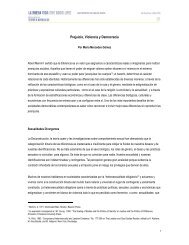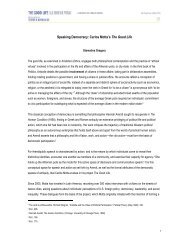Carlos Motta - La buena vida
Carlos Motta - La buena vida
Carlos Motta - La buena vida
You also want an ePaper? Increase the reach of your titles
YUMPU automatically turns print PDFs into web optimized ePapers that Google loves.
108<br />
109<br />
state, one which lies squarely in opposition to<br />
democracy.<br />
<strong>Motta</strong>’s complication of the model provided<br />
by antiquity is also made clear through the<br />
exhibition’s formal attributes. The supportive<br />
structure was built in the round, around a<br />
distinct center point, fitting together into an<br />
abstracted, compacted replica of the Priene.<br />
However, in this installation, the structure<br />
is split into four parts, splayed across the<br />
exhibition space in a way that underscores<br />
its fragmentation, but which still allows for<br />
proximity and intimacy among the pieces.<br />
This arrangement seems to acknowledge the<br />
fundamental split between the classical model<br />
of democracy that the project formally evokes,<br />
and of the democratic models and political<br />
realities of our modern world, which the subjects<br />
in the videos describe. Moreover, it makes a<br />
statement about the contested nature of the<br />
term “democracy” itself; a complex multiplicity of<br />
ideas over which people in political theory, social<br />
movements, and cultural practices hold their<br />
own sets of debates.<br />
Among the plethora of opinions on the<br />
concepts of democracy presented in The Good<br />
Life, one in particular recurs: the view that<br />
democracy necessarily means more than a<br />
single, occasional vote on a predetermined issue,<br />
or a vote for one of a set of pre-selected political<br />
candidates. A Caracas historian <strong>Motta</strong> interviews<br />
points out that the recent efforts in Venezuela<br />
to integrate ordinary citizens in decision making<br />
processes through community councils qualify<br />
that country as a democracy. An 80 year-old<br />
Buenos Aires woman declares that, despite<br />
her age, she has yet to have “lived in an ample<br />
democracy,” while a lawyer in Guatemala City<br />
disavows the term completely for any country<br />
limited to electoral processes. In listening to<br />
their statements, it becomes apparent to the<br />
viewer that Arendt’s well-known arguments<br />
against representative democracy have a<br />
popular echo. For Arendt, the relinquishing of<br />
day-to-day deliberation and action to a small<br />
number of holders of power destroys the “space<br />
of appearance” in which citizenship can be fully<br />
realized. 7 The recuperation of this space clearly<br />
occupies a wider political imaginary for <strong>Motta</strong><br />
and his subjects.<br />
Political philosopher Chantal Mouffe has<br />
written extensively about the impossibility of<br />
a wholly emancipated model of representative<br />
democracy, as well as the inevitable failure of the<br />
linked idea of rational consensus in decisionmaking.<br />
She describes how both these concepts<br />
are inherently flawed as they stem from the<br />
universalizing concept of liberal individualism,<br />
a hegemonic viewpoint that has only increased<br />
with the tide of globalization and that<br />
effectively dismantles possibilities for collective<br />
action. 8 The idea of rational consensus—the<br />
assumption of collective agreement about a set<br />
of predetermined issues—ultimately fails to<br />
acknowledge the constantly shifting dimensions<br />
of power, social divisions and pluralities of<br />
interests and demands. Mouffe notes the way<br />
the rhetoric of consensus effaces discussion<br />
of these pluralities, particularly in the recent<br />
attempt to shift political discourse toward moral<br />
polarities instead of partisan ones (witness<br />
the increasingly popular calls for “bipartisan”<br />
coalitions to address economic issues in the US<br />
government, paired with now-ubiquitous rhetoric<br />
on “evil” and “the enemy.”)<br />
Mouffe argues that citizens need the<br />
possibility of identifying with a range of<br />
democratic political identities. This diversity<br />
of identities must extend beyond a traditional<br />
liberal interpretation of pluralism, which assumes<br />
that an infinite number of voices and values<br />
that can exist harmoniously under the spirit<br />
of individualism. 9 She proposes that instead<br />
of rational consensus we need a consensus of<br />
conflict. To this end, she postulates a model that<br />
7 Eric Wainwright, “The Vita Activa of Hannah Arendt,”<br />
Politikon: South African Journal of Political Studies<br />
(December 1989): 27.<br />
8 Chantal Mouffe, On the Political, (New York:<br />
Routledge, 2005), 10.<br />
9 Ibid., 69.<br />
she calls “agonistic pluralism,” which incorporates<br />
an awareness of the exclusions and power<br />
struggles inherent in society, and integrates these<br />
shifting dynamics, and the identities they form,<br />
into decision-making processes. 10<br />
<strong>Motta</strong>’s multivalent project suggests such a<br />
democratic model. It presents both a multiplicity<br />
of voices, but also demonstrates how those<br />
voices coalesce into collective identifications; of<br />
nationhood, of class, of vocation, and of social<br />
and familial roles (such as the Argentinean<br />
activist group Mothers of Plaza de Mayo he<br />
interviews). By taking as its point of departure<br />
the examination of the political and social<br />
landscape created by policies of intervention,<br />
the project underscores the inevitable shaping<br />
of those identities, and of all political identities,<br />
by conflict.<br />
The project also touches on the profoundly<br />
affective nature of the political. Whether<br />
manifested in a life of labor activism, religious<br />
devotion, hip nihilism, or radical adherence<br />
to nationalist myth, political identification (or<br />
dis-identification) is ultimately a process of<br />
emotion, which any democratic model must<br />
take into account. 11 The role of affect is not<br />
lost on ordinary citizens: as an interviewee in<br />
Tegucigalpa clearly states, “For democracy, there<br />
must be love.” The multitude of narratives in The<br />
Good Life, many of them poignant (such as a tale<br />
of mass extermination of stray dogs in Santiago),<br />
draw us in with their emotional power, thereby<br />
make that power clear. The elaboration of these<br />
narratives makes the case for a democracy of<br />
multiple positions, and incorporates us into an<br />
ongoing, participatory effort, to both speak and<br />
to understand.<br />
Stamatina Gregory is a Whitney <strong>La</strong>uder Fellow<br />
at the Institute for Contemporary Art (ICA) in<br />
Philadelphia and an independent curator.<br />
10 Chantal Mouffe, “Deliberative Democracy or<br />
Agonistic Pluralism?” Social Research (Fall 1999)<br />
11 In taking into account the affective dimension of<br />
politics, Mouffe argues for a serious engagement with<br />
psychoanalysis, specifically Freud and accounts of the<br />
process of identification. Mouffe, On the Political, 25.<br />
an interview on<br />
the interview: a<br />
conversation with<br />
carlos motta<br />
eva díaz<br />
Eva Díaz The most recent addition to your<br />
project The Good Life is a searchable online<br />
archive of the over 400 videotaped interviews<br />
you conducted with pedestrians in 12 <strong>La</strong>tin<br />
American cities about the history of United<br />
States interventions in the region and the<br />
socio-political effects of those disruptions. I will<br />
come to the substance of those interviews in a<br />
minute, but I want to consider the precedents<br />
in film and artistic practice for such a project,<br />
and the interrelated issue of your engagement<br />
with sociological methods such as field research<br />
and participant survey. In particular, an element<br />
of your approach seems to be a readdress of<br />
the history of artist’s uses and appropriations<br />
of sociological/social science methods<br />
(interviews, data collection/archive management,<br />
longitudinal—or in your case latitudinal—<br />
studies, and forms of statistical compilation).<br />
One can trace a lineage from Hans Haacke’s<br />
1970 poll of MoMA visitors’ political opinions<br />
to your work, for instance. On the other hand,<br />
The Good Life hearkens to late 1950s and early<br />
1960s explorations of new forms of documentary<br />
practices such as direct cinema’s innovative<br />
use of hand-held cameras and synch sound, or<br />
more specifically cinéma vérité’s approach to the<br />
passerby in street interviews. How did you come<br />
to the interview as a formal structure?<br />
<strong>Carlos</strong> <strong>Motta</strong> As I started to consider a<br />
formal method to approach my interest in<br />
this fascinating yet enormous subject—the<br />
way we as citizens of <strong>La</strong>tin America perceive<br />
and assimilate personally and collectively the<br />
history of U.S. interventions in the region—I<br />
carefully looked at <strong>La</strong>tin American documentary<br />
film from the 1950s, 1960s and 1970s. These<br />
decades staged several forms of resistance<br />
to what these filmmakers termed “American<br />
imperialism and bourgeois neo-colonialism,” and




